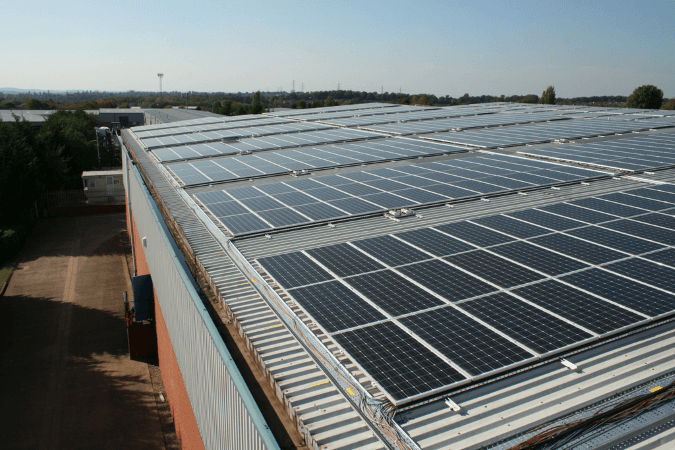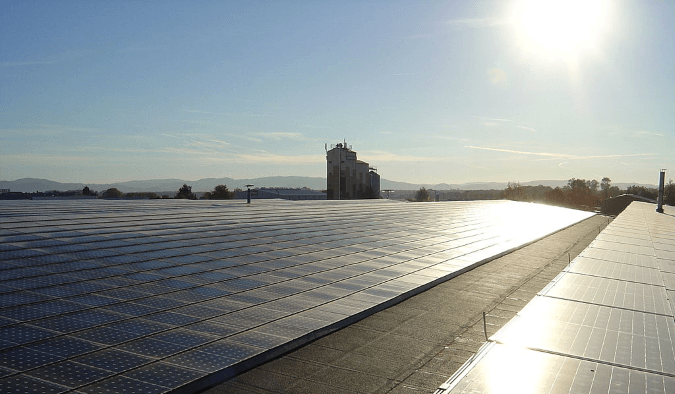In a previously published news article titled ‘Permitted Development Planning Guidance for Solar PV in England’ the latest guidance surrounding Permitted Development (PD) rights for commercial photovoltaic (PV) developments up to 1 megawatt (MW) were presented and discussed. This article expands upon the initial article by discussing, in further depth, the glint and glare issues that surround PD PV rooftop developments. This information is drawn from Pager Power’s experiences of real projects with the aim of educating prospective developers on the issues that may surround a proposed rooftop PV scheme.

Commercial rooftop potential in the UK
In a study produced by Kingspan Energy in 2014 [1], it was calculated that
‘The UK has approximately 2,500km2 of southfacing commercial roof space, of which just 61% (1,525km2 or 589 sq. miles) would need to be covered with solar PV systems to meet current annual business electricity demand.’
This study shows that the UK has a vast potential for commercial rooftop solar in terms of rooftop space availability and therefore understanding the PD legislation is essential.
Permitted Development Rights overview: Glint Glare
Developers of commercial solar PV in England may install systems with a capacity of up to 1MW without obtaining planning permission, however, there are still a number rules that must be followed before installing the panels. These relate to the location of the property, the physical appearance of the panels on the property and the effect of solar glare on surrounding receptors. The legislation can be interpreted such that a glint and glare assessment is required for all solar PV projects with a generative electrical capacity up to 1MW looking to obtain PD rights.
 Figure 1: Rooftop solar development
Figure 1: Rooftop solar development
What does a developer need to do to obtain PD?
PD schemes can be installed without the need for a planning application however consultation with a planning authority is still necessary as stated in the extract below:
‘..the developer must apply to the local planning authority for a determination as to whether the prior approval of the authority will be required as to the design or external appearance of the development, in particular the impact of glare on occupiers of neighbouring land..’
A developer will likely need to send over the following information to the LPA, detailing the proposal:
- A written description of the proposal;
- A plan of the site, showing the proposed development;
- The addresses of any adjoining properties;
- A contact/email address for the developer.
The LPA will then review the information to determine whether the development falls under PD rights, in particular they may consult with local stakeholders to determine whether there are any objections to the proposal.
The LPA will likely be aware of the stakeholders who would want to be informed of a development of this type, however, it may be in a developer’s interest to consult outside of the application in the unlikely event that the LPA does not contact the relevant stakeholders.
The stakeholders who may interest in the possible impact of glare are:
- Airports or airfields
- Network Rail
- The Highways Agency
- Local Residents
Why does glare need to be considered by a developer?
Glare needs to be considered because of the potential safety implications or impacts to local amenity.
What are the typical distances that should be considered with respect to glare for a rooftop development?
We strongly recommend consulting aviation stakeholders if the proposed rooftop development is within 5km of an airfield/airport. In our experience however, objections have been seen out to 6km for rooftop developments so it may be worthwhile consulting out to further distances to be sure this potential issues is ticked off.
For Network Rail Infrastructure, consultation is recommended if a railway line exists within 100m of the proposed rooftop development.
The Highways Agency generally safeguards motorways and A-roads ways, whereas the LPA is more likely to request an assessment of impacts to minor roads. If a road runs adjacent to the building where the PV development is to be sited, an assessment may be requested.
Residents immediately neighbouring a development may not be able to see its rooftop and therefore would be unlikely to object. Furthermore, locations where commercial rooftop PV developments are located are not typically located in residential areas. For this reason, residents that are slightly further away where a view of the rooftop is permitted may be more likely to object. In one project, it was requested that dwellings on a hillside approximately 3km from the proposed rooftop development were assessed. Typical assessment distance for dwellings will vary on a case-by-case basis.
 Figure 2: Sun reflecting on solar panels
Figure 2: Sun reflecting on solar panels
What assessment type is most common for commercial rooftop solar PV under PD?
An aviation assessment is our most commonly requested glare study for a rooftop development. Two reasons these assessments are most common are:
- Ground level receptors, such as road users or local residents, may not be able to view the solar panels. (This is not to say a view of rooftop solar panels is not possible from ground level.)
- Aircraft will be able to see the solar panels whilst transiting the airspace above.
What does a developer need to do?
A developer should ensure that all relevant stakeholders have been contacted, either by the LPA or by the developer themselves. If a stakeholder has not been contacted but subsequently finds out about the development, they can still raise a concern at any point. This will trigger the requirement for a glare assessment which could cause delays or, at worst, cause removal of the solar panels.
Why choose a Pager Power Glint Glare assessment?
We have vast experience assessing and overcoming objections relating to glint glare, in fact we have undertaken over 200 assessments to date. With respect to aviation issues specifically, we gather knowledge from a qualified pilot and have over a decade of understanding aviation issues from working with proposed renewable schemes. We also provided expert testimony regarding glint glare for Ireland’s first large-scale solar development. You can read the case study of our involvement in that project here.
If you would like to learn more, or work together with Pager Power on a glint glare concern, please contact us on 01787 319001 and ask for Danny, or send an email to my address below.
References
[1] Cutting Costs: The Energy Potential of UK Commercial Rooftops, Kingspan Energy, 8th October 2014. (Last accessed 11/04/2016).
Image accreditation: “rooftop view of the solar array” by h080 via Flickr / CC BY-SA 2.0 / Image resized from original.
“Sonnenfleck 1” by Micha Jost / CCBY 3.0 / via WikiMedia / Cropped and resized from original.
